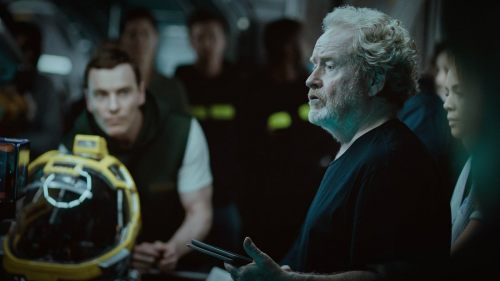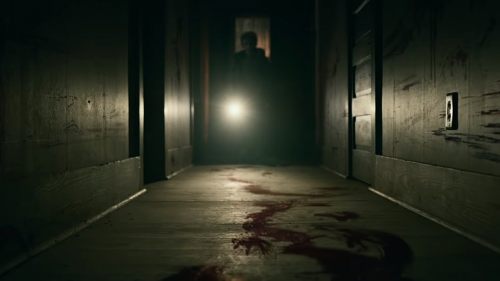THE SHAPE OF WATER Review: A Modern Fairytale
The Shape of Water is the latest and arguably the most Guillermo del Toro film. The monster maestro has always had a penchant for humanizing beasts and for finding the beasts within humans, and Richard Jenkins’ introductory narration here articulates del Toro’s artistic mission statement. This is a story of love and of the monster who tried to destroy it, the “monster” in this case being Michael Shannon’s ruthless Col. Strickland as opposed to Doug Jones’ curious creature; a dramatic irony made obvious at the outset. But del Toro never attempts to hide his intent. Instead, he uses the visual language of fantasy and sci-fi in their simplest, most familiar forms, imbuing them with his childlike sensibility that he balances in turn with his signature maturity. Like Pan’s Labyrinth before it, The Shape of Water is a 20th-century fairytale for adults.
The opening minutes of the film feature a dreamlike sequence of floating furniture – water as fantastical escape – returning to their natural, grounded state as Elisa Esposito (Sally Hawkins), awakens on her lonely couch. The magical introduction transitions swiftly into mundane midnight routine (Elisa’s morning; she works through the night and retires only at sunrise), a routine that involves preparing hard-boiled eggs for her next-door neighbor Giles (Jenkins) and masturbating in her bathtub in the interim. Water as self-indulgence, though del Toro's camera never leers at her, even in the nude. The focus remains largely on her countdown clock or on the boiling eggs with the splashing of bath water occuring out of focus or just off screen; there's a certain innocence to how she's filmed at all times. She goes about her day as a janitor at a secretive research facility, cleaning and keeping her head down before returning home to repeat the process. Work. Sleep. Eggs. Self-satisfaction. She is content, but for the way she’s perceived by the people around her.
Elisa is also mute. She communicates only through sign language, and the visible scars on her neck from when she was harmed as a child make her stick out noticeably. She may be in her forties (presumably; Hawkins is 41), but she’s trapped both by childhood trauma and by the childhood innocence of simple pleasures. Work. Sleep. Eggs. Self-satisfaction. Does she want more? Perhaps. But does she think she deserves it? It’s a question she doesn’t think to consider until the introduction of Doug Jones’ fully-realized amphibian trapped in a research tank – water as torturous prison – a similarly mute humanoid whose gills reflect her scars and whose isolation reflects her own. He is curious, but imposing. Fierce, but intelligent. Part Abe Sapien from Hellboy, part Creature from the Black Lagoon, and entirely lovable despite his monstrous features and demeanor. One of the first things we learn about him is he enjoys the eggs Elisa brings him clandestinely during her lunch break. One of the first things she teaches him is how to sign the word "eggs." It's a secret they share, and it's intrinsically linked to Elisa's desires from the start.
The ’60s setting is vital to The Shape of Water. Rather than feeling like a superficial parable for bigotry, it loads its chamber with live rounds unlike so many modern films about oppression that depend merely on metaphor, and end up exclusionary in the process (Divergent, X-Men, etc.). America, while embroiled in both a Cold War and a Space Race, saw the beginnings of domestic movements that would eventually liberate (to a degree) its black and queer citizens. So it’s no coincidence that Elisa’s closest confidants are her black co-worker Zelda (Octavia Spencer) and her closeted neighbor Giles, a recently unemployed artist smitten with a young diner cashier. Along with the disabled Elisa they’re under the same systemic boot-heel as Doug Jones’ Merman, and are thus poised to understand his predicament.
That boot-heel comes in the form of Michael Shannon’s menacing Richard Strickland, a Colonel so concerned with adhering to social norms that he insists on taping his severed fingers to his hand even after they’ve begun to rot. That is to say, he’s concerned with the appearance of normality – whether in his office or in the facility bathroom, he wields his power over Zelda and Elisa both as their boss and as a man who thinks he can get away with anything. He sees them only in terms their utilities and even fetishizes Elisa's disability, the same way he only sees the creature as something to be torn apart and experimented on so America can push ahead of the Soviets.
The creature is as “other” as any “other” can get, with dangerous fangs and features that are as fish-like as they are human as he moves (temporarily) between breathing mechanisms, yet Elisa understands he’s a sentient being who responds to music and kindness. In turn, he sees Elisa for who she is without looking past her because of her disability. With the help of Michael Stuhlbarg’s kindly scientist, who while complicit in this wartime rat race prioritizes the beauty of living beings over their potential to be exploited, Elisa and Giles hatch a plan to break the creature out of the facility and into her bathtub, and eventually to open ocean – water as freedom – though that’s only the midway point of what The Shape of Water has in store. It has sweet and quiet moments a-plenty amidst its game of cat-and-mouse as Elisa and Zelda are forced to adapt to Strickland's vile sense of "normality" while he searches for infiltrators right beneath his nose, but the real conflict comes in the form of Elisa's newfound sense of self.
As with every del Toro joint, the design feels as melodious as its moving camera. While the film is set in Maryland, it feels like something out of Jean-Pierre Jeunet’s France, from its music, to its whimsy, to its surreal green tinge, to the way every prop and set element straddles the worlds of realism and stylization. It’s a product of our world that feels distinctly otherworldly, focusing the real mechanics of hatred and subjugation upon a being from a realm unknown, in a tale of finding beauty in all things. That includes the alluring depiction of the inevitable (and consensual) physical relationship between Elisa and the creature, beginning in a flooded bathroom amidst a largely implied scene that’s sure to make even the squirmiest of viewers re-orient the limits of their comfort thanks to how victorious it feels for both characters.
While Jones brings an expectedly magnificent physicality to his role, it’s Sally Hawkins who ends up the film’s MVP. Her Elisa is never in need of a drastic arc but she forces change in those around her, as Hawkins either emotes fiercely to put her point across, or attempts to hide her radiant smile. Elisa is an unlikely cinematic heroine, a shy spinster residing above a movie palace, embodying all the passion our cinematic classics tend to beget. Sometimes in the form of incredible musical dream sequences that feel picked from the films of yesteryear, other times in the form of audaciously flipping Strickland off in a language he refuses to understand.
Elisa is drama, romance and adventure rolled into one. The wordless beauty that cinema was and always will be, with kindness and bravery emanating from her very being and filling even the unloved with thoughts of possibility. Moments of peace amidst a torturous status quo, like the wordless lunches she shared with an unlikely stranger. As Elisa and the creature float in their makeshift bathroom-tank, embroiled in a union born of understanding, the overflow trickles downward and intrudes on the unsuspecting movie-goers below. Water, like cinema, as a vessel for the uncontainable.



